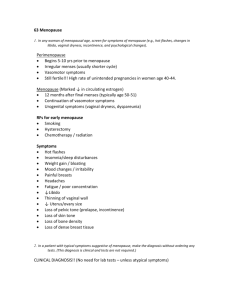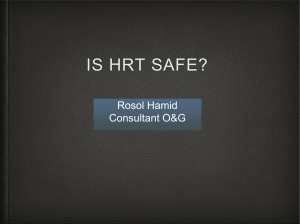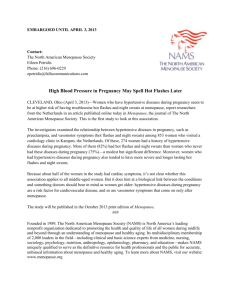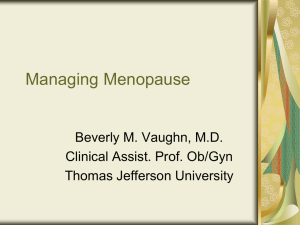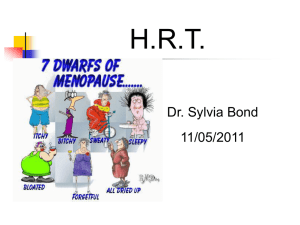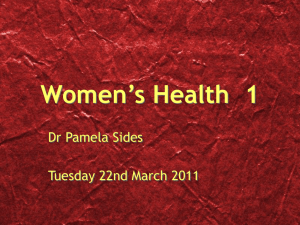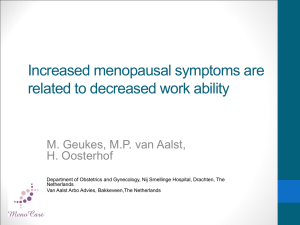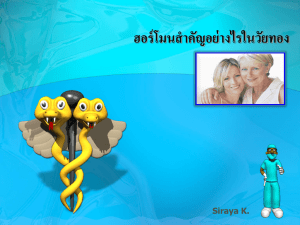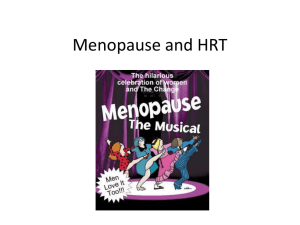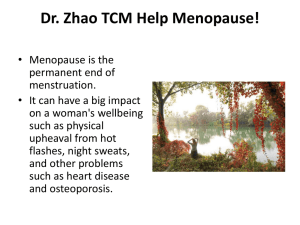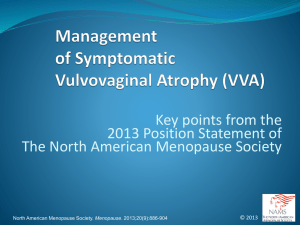What`s New in Menopausal Medicine?
advertisement
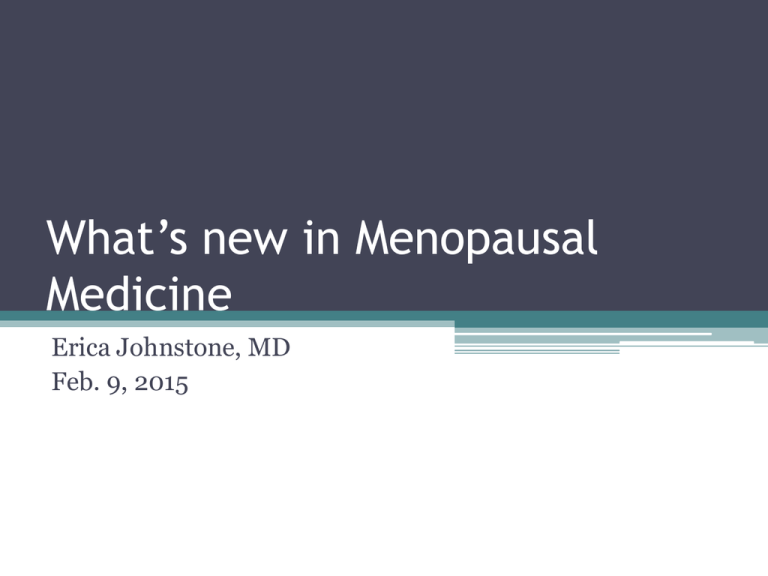
What’s new in Menopausal Medicine Erica Johnstone, MD Feb. 9, 2015 Objectives • Review innovations in the management of menopause and perimenopause in the past 2 years • Understand the North American Menopause Society Recommendations for Clinical Care of Midlife Women and their implications New Products: DuaVee • Conjugated estrogens 0.45 mg/Bazedoxifene 20 mg tablets • Bazedoxifene is a SERM, originally developed, but not FDA-approved for osteoporosis • Alternative to progestin to prevent endometrial hyperplasia or cancer New Products: DuaVee • FDA approved October 2013 • Indications: ▫ Moderate to severe vasomotor symptoms associated with menopause ▫ Prevention of menopausal osteoporosis DuaVee: Effectiveness • Mean reduction in hot flashes of 2.7 per day greater than placebo at 12 weeks • 1.6-1.7% increase in lumbar spine bone mineral density at 24 months, compared with 1.5-2% decrease in placebo groups DuaVee: Risks • 0.7% incidence of endometrial hyperplasia or malignancy at 24 months • Postmenopausal bleeding did not differ from placebo • No apparent increase in VTE, stroke, or CHD over placebo at 24 months • Presumed to have the same safety profile as ERT based on WHI data New Products: Brisdelle • Paroxetine 7.5 mg qhs • Lower dose than used for major depressive disorder (10-60 mg daily) • Reduction in moderate and severe hot flashes by 0.9 to 1.7 per day compared with placebo in 2 RCTs • Interaction with tamoxifen lowers tamoxifen effectiveness Simon et al, 2013 Preliminary data from the ELITE Trial • Early versus late Intervention Trial of Estrogen • 643 postmenopausal women ▫ Half menopausal <6 years ▫ Half menopausal >10 years • 1 mg 17 beta-estradiol versus placebo. • 10 days per month of micronized progesterone vaginal gel or placebo for women with a uterus • Early intervention group using estrogen had slower progression of atherosclerosis measured by carotid IMT than the women randomized to placebo. • No difference based on estrogen in the late intervention group. • P value for interaction was .007. North American Menopause Society Recommendations: Contraception • Low dose oral contraceptives are appropriate for heavy menstrual bleeding and irregularity in perimenopause (Level I) • Contraception should be continued until 12 months of amenorrhea (Level I) NAMS: Treatment of Vasomotor Symptoms • Hormone replacement therapy • Brisdelle (paroxetine 7.5 mg) is FDA approved • Other SSRIs with demonstrated efficacy include paroxetine, escitalopram, venlafaxine, and desvenlafaxine; paroxetine • Gabapentin and clonidine reduce hot flashes but have not been approved by FDA for this indication. NAMS: HRT • A prolonged course of HRT can be considered for treatment of symptoms or osteoporosis if alternatives are not appropriate (Level III) • HRT is recommended for women with early menopause or primary insufficiency until age 52, and longer durations can be considered to treat symptoms. (Level II) NAMS: Bioidentical HRT • Compounded HRT is not receommended due to concerns about quality, safety, and efficacy (Level I) • Neither serum nor salivary hormone levels are recommended to monitor therapy for menopausal symptoms. (Level II) • Prescription of FDA-approved natural products (estradiol, progesterone) is recommended for women who prefer bioidentical HRT (Level II) A Reminder… • Hormone replacement therapy does not prevent or treat cardiovascular disease • Cardiovascular effects of HRT are more favorable in women 50-59 years and within 10 years of menopause when treatment is initiated (Level I) NAMS: Genitourinary Syndrome of Menopause • Low-dose vaginal estrogen is effective and does not require progestin therapy. (Level I) • The estrogen agonist/antagonist ospemifene is an oral agent for the treatment of moderate to severe dyspareunia due to GSM/VVA. (Level I) • Postmenopausal women with recurrent UTIs may consider treatment with low-dose vaginal ET or prophylactic antibiotics. (Level I) NAMS: Sexual Function • Bupropion and PDE-5 inhibitors may have a role in the treatment of SSRI-induced sexual dysfunction. (Level II) • No role for DHEA NAMS: Androgen Therapy • Testosterone therapy may benefit some postmenopausal women with female sexual interest/arousal disorder, but there are no formulations available for women in the US and inadequate long-term safety (Level I) • Monitoring of testosterone therapy should include assessment of facial hair, acne, virilization, and adverse changes in lipids or liver function tests. • Blood testosterone levels should be maintained in the normal range for reproductive-aged women. (Level II) NAMS: Hair loss and hirsutism • First line for FPHL: Topical minoxidil 5% (FDAapproved) • Limited evidence supports addition of an antiandrogen (spironolactone) (Level II) • Hair loss is not an indication for HT use (Level II) • Ketoconazole 2% and zinc pyrithione 1% shampoos may increase scalp hair growth. (Level II) NAMS: Weight gain and obesity • Mean weight gain across menopause is 5 lb (2.3 kg) • Consider medical treatment in addition to diet and exercise in women with a BMI greater than 30 kg/m2 or BMI greater than 27 kg/m2 with comorbidities (Level II) • Consider bariatric surgery in women with a BMI of 40 kg/m2 or higher or a BMI greater than 35 kg/m2 with comorbidities who have failed conservative measures. (Level II) NAMS: Migraines • Hormone therapy at standard doses is appropriate for postmenopausal women with migraines, but may worsen headaches in some women • Continuous rather than cyclic HT is recommended as changes in hormone levels may trigger a headache (Level II) NAMS: Breast cancer • Combined HRT increases breast cancer risk beyond 3-5 years • ERT does not increase breast cancer risk in the first 7 years, but may thereafter • SERMs (tamoxifen, raloxifene) reduce the incidence of primary breast cancer in high-risk women. • Bazedoxifene effects on breast cancer risk not yet adequately studied NAMS: Soy and phytoestrogens • Soy isoflavones may protect against breast cancer during breast development. • Soy isoflavones in early menopause may inhibit the progression of atherosclerosis. • Soy isoflavones and phytoestrogens are not known to increase the risk of breast or endometrial cancer, but women with breast or endometrial cancer are advised to discuss their use with their oncologist. (Level II) NAMS: Supplements • OTC topical progesterone cream does not provide endometrial protection or benefit for menopausal symptoms (Level III) • Oral DHEA has not been shown to improve mood, sexual function, or general well-being (Level III) • Melatonin may help with circadian-rhythm sleep disorders (Level II) References • Hodis HN, et al. Testing the menopausal hormone therapy timing hypothesis: The early versus late intervention trial with estradiol. AHA 2014; Abstract 13283. • Shifren L, Gass MLS, for the NAMS Recommendations for Clinical Care of Midlife Women Working Group. The North American Menopause Society Recommendations for Clinical Care of Midlife Women. Menopause 2014;21(10):1038-1062 • Simon JA, et al. Low-dose paroxetine 7.5 mg for menopausal vasomotor symptoms: two randomized controlled trials. Menopause 2013 Oct;20(10):1027-35. doi: 10.1097/GME.0b013e3182a66aa7. • Duavee Prescribing Information
